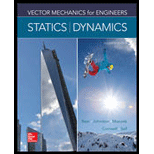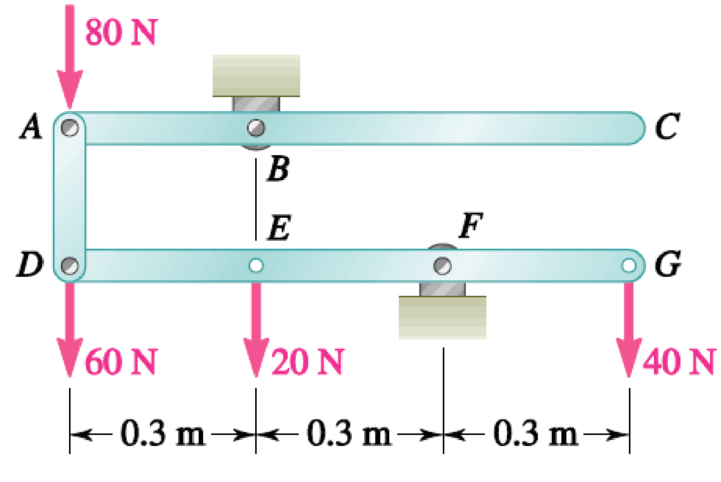
Vector Mechanics for Engineers: Statics and Dynamics
11th Edition
ISBN: 9780073398242
Author: Ferdinand P. Beer, E. Russell Johnston Jr., David Mazurek, Phillip J. Cornwell, Brian Self
Publisher: McGraw-Hill Education
expand_more
expand_more
format_list_bulleted
Concept explainers
Textbook Question
Chapter 10.1, Problem 10.1P
Determine the vertical force P that must be applied at C to maintain the equilibrium of the linkage.

Expert Solution & Answer
Want to see the full answer?
Check out a sample textbook solution
Students have asked these similar questions
Can you provide steps and an explaination on how the height value to calculate the Pressure at point B is (-5-3.5) and the solution is 86.4kPa.
PROBLEM 3.46
The solid cylindrical rod BC of length L = 600
mm is attached to the rigid lever AB of length a
= 380 mm and to the support at C. When a 500
N force P is applied at A, design specifications
require that the displacement of A not exceed
25 mm when a 500 N force P is applied at A
For the material indicated determine the
required diameter of the rod.
Aluminium: Tall = 65 MPa, G = 27 GPa.
A
Find the equivalent mass of the rocker arm assembly with respect to the x coordinate.
k₁
mi
m2
k₁
Chapter 10 Solutions
Vector Mechanics for Engineers: Statics and Dynamics
Ch. 10.1 - Determine the vertical force P that must be...Ch. 10.1 - Determine the horizontal force P that must be...Ch. 10.1 - Prob. 10.3PCh. 10.1 - Prob. 10.4PCh. 10.1 - Prob. 10.5PCh. 10.1 - A spring of constant 15 kN/m connects points C and...Ch. 10.1 - The two-bar linkage shown is supported by a pin...Ch. 10.1 - Prob. 10.8PCh. 10.1 - Prob. 10.9PCh. 10.1 - Prob. 10.10P
Ch. 10.1 - Prob. 10.11PCh. 10.1 - Prob. 10.12PCh. 10.1 - Prob. 10.13PCh. 10.1 - Prob. 10.14PCh. 10.1 - Prob. 10.15PCh. 10.1 - Prob. 10.16PCh. 10.1 - Prob. 10.17PCh. 10.1 - Prob. 10.18PCh. 10.1 - Prob. 10.19PCh. 10.1 - Prob. 10.20PCh. 10.1 - Prob. 10.21PCh. 10.1 - A couple M with a magnitude of 100 Nm isapplied as...Ch. 10.1 - Rod AB is attached to a block at A that can...Ch. 10.1 - Solve Prob. 10.23, assuming that the 800-N force...Ch. 10.1 - Prob. 10.25PCh. 10.1 - Prob. 10.26PCh. 10.1 - Prob. 10.27PCh. 10.1 - Prob. 10.28PCh. 10.1 - Prob. 10.29PCh. 10.1 - Two rods AC and CE are connected by a pin at Cand...Ch. 10.1 - Solve Prob. 10.30 assuming that force P is movedto...Ch. 10.1 - Prob. 10.32PCh. 10.1 - Prob. 10.33PCh. 10.1 - Prob. 10.34PCh. 10.1 - Prob. 10.35PCh. 10.1 - Prob. 10.36PCh. 10.1 - Prob. 10.37PCh. 10.1 - Prob. 10.38PCh. 10.1 - Prob. 10.39PCh. 10.1 - Prob. 10.40PCh. 10.1 - Prob. 10.41PCh. 10.1 - The position of boom ABC is controlled by...Ch. 10.1 - Prob. 10.43PCh. 10.1 - Prob. 10.44PCh. 10.1 - Prob. 10.45PCh. 10.1 - Prob. 10.46PCh. 10.1 - Denoting the coefficient of static friction...Ch. 10.1 - Prob. 10.48PCh. 10.1 - Prob. 10.49PCh. 10.1 - Prob. 10.50PCh. 10.1 - Prob. 10.51PCh. 10.1 - Prob. 10.52PCh. 10.1 - Prob. 10.53PCh. 10.1 - Prob. 10.54PCh. 10.1 - Prob. 10.55PCh. 10.1 - Prob. 10.56PCh. 10.1 - Prob. 10.57PCh. 10.1 - Prob. 10.58PCh. 10.2 - Using the method of Sec. 10.2C, solve Prob. 10.29....Ch. 10.2 - Prob. 10.60PCh. 10.2 - Prob. 10.61PCh. 10.2 - Prob. 10.62PCh. 10.2 - Prob. 10.63PCh. 10.2 - Prob. 10.64PCh. 10.2 - Prob. 10.65PCh. 10.2 - Using the method of Sec. 10.2C, solve Prob. 10.38....Ch. 10.2 - Prob. 10.67PCh. 10.2 - Prob. 10.68PCh. 10.2 - Prob. 10.69PCh. 10.2 - Prob. 10.70PCh. 10.2 - Prob. 10.71PCh. 10.2 - Prob. 10.72PCh. 10.2 - Prob. 10.73PCh. 10.2 - Prob. 10.74PCh. 10.2 - Prob. 10.75PCh. 10.2 - Prob. 10.76PCh. 10.2 - Prob. 10.77PCh. 10.2 - Prob. 10.78PCh. 10.2 - Prob. 10.79PCh. 10.2 - Prob. 10.80PCh. 10.2 - Prob. 10.81PCh. 10.2 - A spring AB of constant k is attached to two...Ch. 10.2 - Prob. 10.83PCh. 10.2 - Prob. 10.84PCh. 10.2 - Prob. 10.85PCh. 10.2 - Prob. 10.86PCh. 10.2 - Prob. 10.87PCh. 10.2 - Prob. 10.88PCh. 10.2 - Prob. 10.89PCh. 10.2 - Prob. 10.90PCh. 10.2 - Prob. 10.91PCh. 10.2 - Prob. 10.92PCh. 10.2 - Prob. 10.93PCh. 10.2 - Prob. 10.94PCh. 10.2 - Prob. 10.95PCh. 10.2 - Prob. 10.96PCh. 10.2 - Bars AB and BC, each with a length l and of...Ch. 10.2 - Prob. 10.98PCh. 10.2 - Prob. 10.99PCh. 10.2 - Prob. 10.100PCh. 10 - Determine the vertical force P that must be...Ch. 10 - Determine the couple M that must be applied...Ch. 10 - Prob. 10.103RPCh. 10 - Prob. 10.104RPCh. 10 - Prob. 10.105RPCh. 10 - Prob. 10.106RPCh. 10 - Prob. 10.107RPCh. 10 - Prob. 10.108RPCh. 10 - Prob. 10.109RPCh. 10 - Prob. 10.110RPCh. 10 - Prob. 10.111RPCh. 10 - Prob. 10.112RP
Additional Engineering Textbook Solutions
Find more solutions based on key concepts
What is an uninitialized variable?
Starting Out with Programming Logic and Design (5th Edition) (What's New in Computer Science)
Porter’s competitive forces model: The model is used to provide a general view about the firms, the competitors...
Management Information Systems: Managing The Digital Firm (16th Edition)
The solid steel shaft AC has a diameter of 25 mm and is supported by smooth bearings at D and E. It is coupled ...
Mechanics of Materials (10th Edition)
What types of coolant are used in vehicles?
Automotive Technology: Principles, Diagnosis, And Service (6th Edition) (halderman Automotive Series)
17–1C A high-speed aircraft is cruising in still air. How does the temperature of air at the nose of the aircra...
Thermodynamics: An Engineering Approach
How is the hydrodynamic entry length defined for flow in a pipe? Is the entry length longer in laminar or turbu...
Fluid Mechanics: Fundamentals and Applications
Knowledge Booster
Learn more about
Need a deep-dive on the concept behind this application? Look no further. Learn more about this topic, mechanical-engineering and related others by exploring similar questions and additional content below.Similar questions
- 2. Figure below shows a U-tube manometer open at both ends and containing a column of liquid mercury of length l and specific weight y. Considering a small displacement x of the manometer meniscus from its equilibrium position (or datum), determine the equivalent spring constant associated with the restoring force. Datum Area, Aarrow_forward1. The consequences of a head-on collision of two automobiles can be studied by considering the impact of the automobile on a barrier, as shown in figure below. Construct a mathematical model (i.e., draw the diagram) by considering the masses of the automobile body, engine, transmission, and suspension and the elasticity of the bumpers, radiator, sheet metal body, driveline, and engine mounts.arrow_forward3.) 15.40 – Collar B moves up at constant velocity vB = 1.5 m/s. Rod AB has length = 1.2 m. The incline is at angle = 25°. Compute an expression for the angular velocity of rod AB, ė and the velocity of end A of the rod (✓✓) as a function of v₂,1,0,0. Then compute numerical answers for ȧ & y_ with 0 = 50°.arrow_forward
- 2.) 15.12 The assembly shown consists of the straight rod ABC which passes through and is welded to the grectangular plate DEFH. The assembly rotates about the axis AC with a constant angular velocity of 9 rad/s. Knowing that the motion when viewed from C is counterclockwise, determine the velocity and acceleration of corner F.arrow_forward500 Q3: The attachment shown in Fig.3 is made of 1040 HR. The static force is 30 kN. Specify the weldment (give the pattern, electrode number, type of weld, length of weld, and leg size). Fig. 3 All dimension in mm 30 kN 100 (10 Marks)arrow_forward(read image) (answer given)arrow_forward
- A cylinder and a disk are used as pulleys, as shown in the figure. Using the data given in the figure, if a body of mass m = 3 kg is released from rest after falling a height h 1.5 m, find: a) The velocity of the body. b) The angular velocity of the disk. c) The number of revolutions the cylinder has made. T₁ F Rd = 0.2 m md = 2 kg T T₂1 Rc = 0.4 m mc = 5 kg ☐ m = 3 kgarrow_forward(read image) (answer given)arrow_forward11-5. Compute all the dimensional changes for the steel bar when subjected to the loads shown. The proportional limit of the steel is 230 MPa. 265 kN 100 mm 600 kN 25 mm thickness X Z 600 kN 450 mm E=207×103 MPa; μ= 0.25 265 kNarrow_forward
- T₁ F Rd = 0.2 m md = 2 kg T₂ Tz1 Rc = 0.4 m mc = 5 kg m = 3 kgarrow_forward2. Find a basis of solutions by the Frobenius method. Try to identify the series as expansions of known functions. (x + 2)²y" + (x + 2)y' - y = 0 ; Hint: Let: z = x+2arrow_forward1. Find a power series solution in powers of x. y" - y' + x²y = 0arrow_forward
arrow_back_ios
SEE MORE QUESTIONS
arrow_forward_ios
Recommended textbooks for you
 International Edition---engineering Mechanics: St...Mechanical EngineeringISBN:9781305501607Author:Andrew Pytel And Jaan KiusalaasPublisher:CENGAGE L
International Edition---engineering Mechanics: St...Mechanical EngineeringISBN:9781305501607Author:Andrew Pytel And Jaan KiusalaasPublisher:CENGAGE L

International Edition---engineering Mechanics: St...
Mechanical Engineering
ISBN:9781305501607
Author:Andrew Pytel And Jaan Kiusalaas
Publisher:CENGAGE L
Physics - Thermodynamics: (21 of 22) Change Of State: Process Summary; Author: Michel van Biezen;https://www.youtube.com/watch?v=AzmXVvxXN70;License: Standard Youtube License